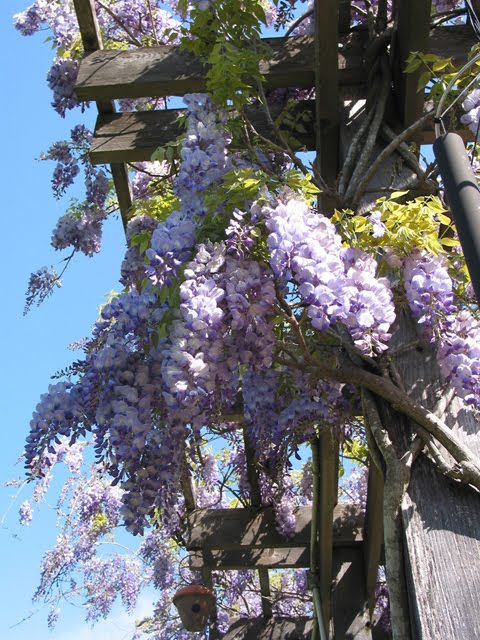
|
| The incomparable beauty and intense aroma of wisteria is one of Spring's best gifts! |
I grow Purple ‘Cooke’s Special’ Wisteria (a Chinese variety known as Wisteria sinensis ‘Cooke’s Purple). It has an impressive Spring show of large, beautiful dark lavender blossoms, and it produces numerous smaller displays of blooms during the Summer months. It blooms best in full sun, even here in Central Texas, and the good news is that it is drought tolerant.

|
| A really sturdy support system is necessary for wisteria. Our pergola is built to withstand the vines' strong climbing habits. |
Remember, a wisteria grows vigorously and can tear down just about anything, so keep that in mind when selecting a planting location. Mine were trained to climb a pergola, built with 6’ x 6’ treated cedar posts bolted into concrete footings.
Initially, you’ll be spending significant time trimming your wisteria to keep it focused on growth of the main axis. (I know you want flowers immediately, but be patient and focus on getting this plant strong and healthy enough to give you the best blooms in a year or two.)
In its first couple of years, discourage flower displays and seed pod development. Trim these, but do promote selective growth of new vines. Fertilizing your plants monthly (we prefer to use Medina Hasta Gro) with organic feedings during growing season will encourage strong, young vines, rather than flowers. As the plant matures and reaches the desired height, it’s time to let it blossom. However, keep cutting off those seed pods to so that the plant’s energy is focused on blooming, not reproduction. To get the flower show you’ve waited for, withhold the feedings from the time the plant begins to leaf out in Spring until blooming has completed, then resume fertilization.

|
| Our wisteria presents flowers (racemes) first, then will leaf out along new vines. |
The only pests I have encountered on my wisteria are 'twig girdlers.' These little guys are the insect kingdom's answer to the beaver. They will chew their way around a branch until it looks like it has been through a pencil sharpener, then drill their menancing little bodies into the dying wood to deposit their eggs. The story will repeat itself the following Spring unless you pull off the damaged branches and throw them in the garbage. Do not compost these or you'll find girdlers making their way throughout your garden and into all of your trees.
Enjoy the blooms, drink up the scent and appreciate the shaded respite wisteria provides all summer and fall!
0 comments:
Post a Comment